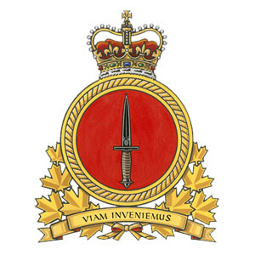 Last month, I posted an item on the organization of the Canadian Army, but I didn’t include the Canadian special forces … partly because the special forces are Canada’s “fourth” branch of service and not organizationally part of the Canadian Army … and partly because I just plain forgot about them. Having just read a short article in the most recent Dorchester Review, I was reminded to include Canada’s special forces units (as much as we know about them, anyway). Special forces fall under their own service command, separate from the Canadian Army, the Royal Canadian Navy, and the Royal Canadian Air Force, known as the Canadian Special Operations Forces Command (CANSOFCOM), established in 2006.
Last month, I posted an item on the organization of the Canadian Army, but I didn’t include the Canadian special forces … partly because the special forces are Canada’s “fourth” branch of service and not organizationally part of the Canadian Army … and partly because I just plain forgot about them. Having just read a short article in the most recent Dorchester Review, I was reminded to include Canada’s special forces units (as much as we know about them, anyway). Special forces fall under their own service command, separate from the Canadian Army, the Royal Canadian Navy, and the Royal Canadian Air Force, known as the Canadian Special Operations Forces Command (CANSOFCOM), established in 2006.
The core unit of CANSOFCOM is the original Joint Task Force-2 (JTF2) which was formed in 1992-3 when the Canadian Forces took over the domestic counterterrorism role from the RCMP. When JTF2 was included in the new command, other units were established to support a wider range of missions and capabilities. CANSOFCOM is headed by a Brigadier General and composed of a headquarters and the following units:
Although the official web page for CANSOFCOM emphasizes its domestic role, Canadian special forces have also been involved in overseas operations beginning (so far as we know) with Afghanistan in 2001-2. Very little information about JTF2 missions in specific or CANSOFCOM in general has been released by the government, and this is unlikely to change in the near future. Joseph Jockel’s article in the Dorchester Review states:
The consequences of the successful deployment […] are clearer. JTF2 had been tested and admitted to the “international tier 1 counterterrorism community”, the other members being the special forces of the US, UK, and Australia. A good indication of this was that the US military planned to include Canadian special forces in the 2003 invasion of Iraq. A year after Canada declined to go to Iraq, “the US government sends a démarche to Ottawa specifically requesting JTF2 deploy to Afghanistan for a second one-year commitment”. Ottawa “obliges relatively quickly to the US request for forces and CANSOF deploys for a second one-year commitment in the summer 2005”
The Wikipedia page has more:
Core tasks
CANSOFCOM’s core tasks are: to provide the Canadian Forces with a capacity to prevent and react to terrorism in all environments, to provide the CF with a capability to perform other missions as directed by the Government of Canada, such as direct action (DA), special reconnaissance (SR), defence diplomacy and military assistance (DDMA), as well as special humanitarian assistance (such as the evacuation of non-combatants).
Commanding officers
On September 12, 2005, Colonel David Barr was appointed the provisional commander of the CANSOFCOM. During his tenure as commander, Colonel Barr also deployed to Afghanistan as commander of the Canadian special operations task force in Operation Enduring Freedom.
Major-General D. Michael Day, OMM CD – Commander of the Canadian Special Operations Forces Command 2007–2011
Brigadier-General D.W. Thompson, OMM MSC CD is the current commander of the Canadian Special Operations Forces Command, appointed in April 2011.
The current command chief warrant officer is Chief Warrant Officer John H. Graham, MSM CD.
Uniform
With operational uniforms, all members of CANSOFCOM wear the tan beret, regardless of their environment (navy, army or air force), with the badge of their personnel branch or, in the case of the Royal Canadian Armoured Corps and Royal Canadian Infantry Corps members, the badge of their former regiment. With ceremonial and service dress, navy members wear service caps with tan bands, army members wear tan berets and air force members wear blue wedge caps with a tan insert.

 Last month, I posted an item on the
Last month, I posted an item on the 

